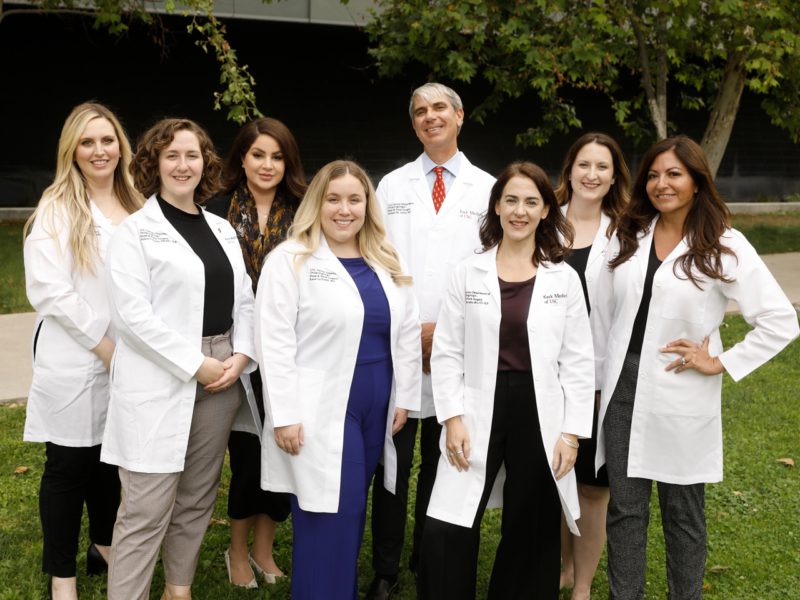By: Mollie Barnes

USC Voice Center Team from left to right: Elizabeth Shuman, MD, Felicia Francois, CCC-SLP, Erika Arezomanians (Patient Navigator), Kacie La Forest, CCC-SLP, Michael Johns, MD, Eugenia Castro, CCC-SLP, Lauren Timmons-Sund, CCC-SLP, and Karla O’Dell, MD. Photo Credit: Steve Cohn
It is said that health is the invisible crown, you don’t know you’re wearing it until you lose it. Having a voice is kind of like that, too. It’s something so critical to your everyday functioning, but you probably don’t think about it unless you’re having issues with it.
“Despite voice being so critically important to our ability to function in the world, it tends to live lower in public health priorities to things like diabetes or cancer and certain other life-threatening diseases, and as a result, it tends to be underfunded in terms of research dollars to support advances and voice disorders,” said Michael Johns, III, MD, an otolaryngologist at the USC Caruso Department of Otolaryngology – Head and Neck Surgery and director of the USC Voice Center.
That’s exactly why one of the missions of the USC Voice Center is to raise awareness around the voice and voice disorders. Three of the things they focus on for outreach are 1) Walk for Talk, an annual four-day event to benefit Dysphonia International, which raises money to fund vital research to defeat spasmodic dysphonia and related voice conditions, 2) the LA Pride Parade, an annual parade for LGBTQ+ pride, and 3) a collaboration with the USC Thornton School of Music to provide vocal health and wellness support for developing vocalists.
“Participating in these programs energizes us towards advancing our clinical care further and enhancing our educational programs to be as robust as possible,” said Dr. Johns. “These kinds of interactions, when we interact with people in the lived experience of a voice disorder, always helps us generate hypotheses for novel research.”
For example, the primary treatment for the rare voice condition called spasmodic dysphonia is botulinum toxin injections (Botox) injections, into the vocal fold muscles, commonly called vocal cords. The treatment is quite effective for most people, restoring their voice and allowing them to function in their vocal lives. Botox is also used for other neurologic conditions, and insurance companies somewhat arbitrarily only cover treatments every three months, Dr. Johns said.
“Through our engagement with our patients and at Walk for Talk, we discovered many people need treatment more frequently than three months,” Dr. Johns said.
But insurance companies won’t cover that.
“We have a collection of patients who are very frustrated by the inability to access treatment. And we listen, and we hear these stories, and so we decided that we should investigate this further. We had a specific research question, which was: how many people require treatment at intervals shorter than three months?
“And the answer was about 30% of people.”
The research collaboration with University of California San Francisco and University of Washington provided the evidence they needed to show insurance companies to get treatment approved for their patients.
“We showed insurance companies the evidence, and now we’ve made a fundamental change for our patients for the positive,” Dr. Johns said. “All that came from patient outreach and engagement.”
Patient outreach is also important when it comes to LGBTQ+ issues, as voice is commonly tied to judgements about gender identity.
“And people can make judgments when your voice does not match your gender identity,” Dr. Johns said.
People commonly make all kinds of judgments about voice in general if your voice is unstable, perhaps inferring that you are nervous, uneducated, cognitively impaired, intoxicated or more. None of these things might necessarily be true.
“We have expert clinicians — physicians, voice specialists, speech language pathology specialists and voice rehabilitation specialists — who are trained to help people through behavior modifications or surgery, as needed, with care that is individualized to each patient to help,” he said. “Treatment is effective and there were a lot of social barriers for a long time to delivering this care. But fortunately here in California, we have the means and oftentimes now insurance support, to be able to deliver this care to provide meaningful improvements in these individuals’ quality of life.”
Increasing quality of life is also important for the developing vocalists at USC Thornton School of Music. Each year, the USC Voice Center shares information about vocal health and vocal injury prevention and provides vocal health screenings to all new incoming vocal students.
“Our vocal performers use their voice at an incredibly high level, in a very dynamic ways,” Dr. Johns says of the USC Thornton School of Music students. “These are vocal athletes. And they are artists, as well. Unlike other musicians, where if your guitar breaks or your saxophone breaks you can go buy yourself a new instrument, these students only have one instrument. And it’s their voice box. So preventing voice disorders is crucial.”
This year’s Walk For Talk is happening on October 14. To sign up to walk with the USC Voice Center please email Toni Gold, our Los Angeles Walk for Talk organizer at Toni.gold2@gmail.com